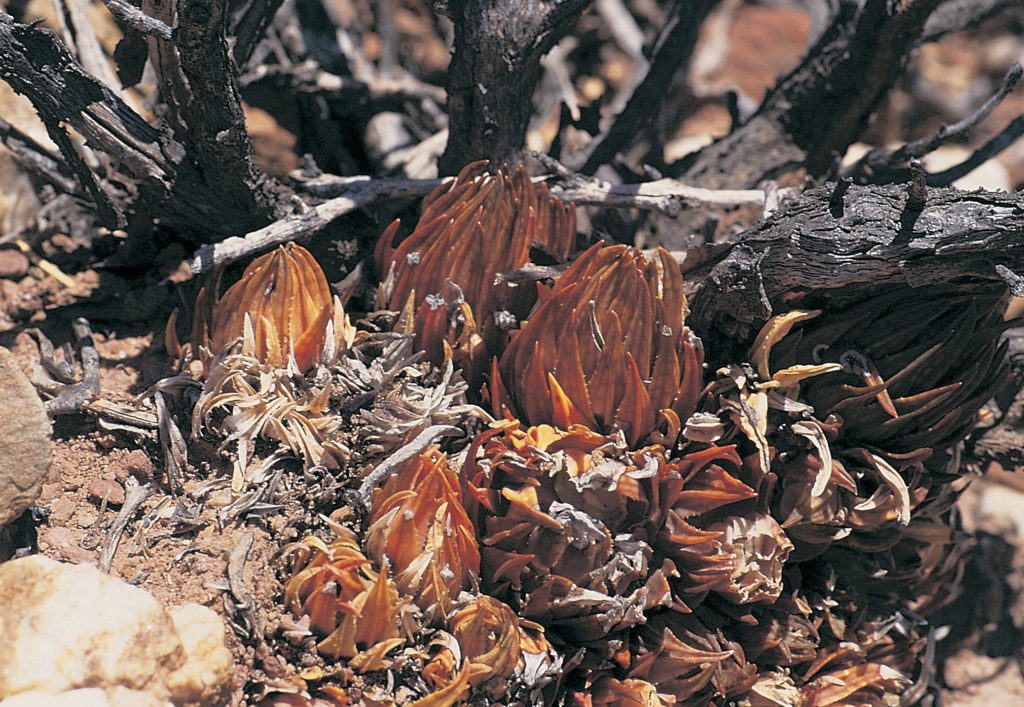29. Haworthia pulchella Bayer, JS.Afr.Bot. 39:232(1973). Bayer :147(1976). Bayer :51(1982). Scott :63(1985). Type: CAPE‑3320 (Montagu): Avondrust, Touws River (‑AC), Bayer 163 (NBG).
pulchella: very beautiful.
Rosette stemless, occasionally proliferous, to 5cm φ. Leaves 30-45, incurved, coriaceous, block-patterned reticulation, dark- to emerald-green, with pronounced whitish spines on margins and keel. Inflorescence simple, slender, to 30cm. Flowers 15-20, white.
1982 – This is a small compact, dark‑green species. The leaves are armed with pronounced white spines. The distribution is from near Constable Station in the east, to west and south of Touws River. Von Poellnitz recorded H. angustifolia from Touws River but it is difficult to believe that he was confusing this species with H. pulchella. The leaves in the latter species are firmer, shorter and incurved. H. pulchella is always in the shade and is also a winter‑growing species. It is very seldom proliferous and is very slow growing. The most likely relative is probably H. wittebergensis primarily on the basis of distribution and the moderately coriaceous texture of the leaves.
1999 – The range of this species has also been extended with new records from further to the east, at least as far as the Anysberg. There is a will to associate this species with H. wittebergensis which I think overlooks the more probable affinity of that species to H. blackburniae on the basis of stem structure (granular and woody) and on the same amplexicaul leaf bases. H. pulchella has a soft textured stem and the leaves are normally inserted on the stem as for, say, H. marumiana. This comparison is made because Col Scott suggests the extension of H. pulchella up to the Nuweveld Mountains at Beaufort West where he suggests that it also occurs, although his distribution map does not show this. That is incorrect as H. pulchella is with fair certainty restricted to the Touws River-Laingsburg-Hoekvandieberg triangle. It is curious to see the resemblance which H. maraisii has to this species growing on identical Witteberg quartzites, together even with Protea sulphurea and other Dry Mountain Fynbos species, near Bonnievale. The distribution of H. margaritifera supports this distant connection and it may be more reasonable to seek some affinity of H. pulchella in the south-west, rather than eastward. The species is not restricted to shade and specimens have been seen growing in very exposed sites, although obviously not preferred.

a. var. pulchella
Distribution: 3319 (Worcester): W. Touws River (-BD), Bayer 2582 (NBG). 3320 (Montagu): SE. Konstabel Stat. (-AB), Bayer 2093 (NBG); Avondrust, Touws River (‑AC), Bayer 163 (NBG); Spreeufontein (-AC), Bruyns 2425 (NBG); Nougaspoort (-CA), Bayer (NBG); SW. Anysberg (-CB), Bayer (NBG).


b. var. globifera var. nov.
Type: CAPE-3320 (Montagu): SE Anysberg Bruyns 7338 (BOL, Holo.).
globifera: forming globose clusters and rosettes.
Differs from the species in being glabrous, slightly stem forming and also forming clusters. (A var. pulchella foliis glabris differt.)
The typical variety is seldom proliferous and usually slowly so. The population southwest of the Anysberg is unusual in that the plants form compact clusters well protected on south facing slopes. The new variety requires less protection, forms larger, more raised clusters and there is some degree of stem formation with offsets above the base. The leaves are incurved to form very neat, tight clusters which suggested the name.
Distribution: 3319 (Montagu): SE Anysberg (-DB), Bruyns 7338 (BOL).

